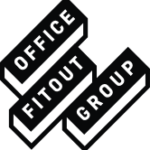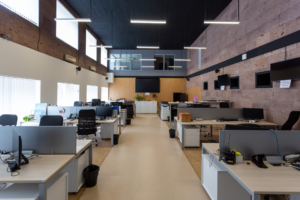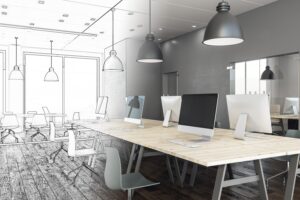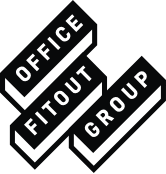So, you want to plan an office space that is the perfect size for your team to reach productivity goals, fosters creativity and has enough extra space for expansion. How do you calculate how much office space you will need?
Before you sign the lease, it is advisable to have a system in place that takes into account all your needs and the key factors on how much office space you will need. Determining the right amount of space is crucial for both practical and financial reasons. An office too small or an office too big can be costly. The wrong square footage could interrupt your business operations. Therefore, careful planning is critical to estimate or calculate the space your company needs and visualise what the space will be used for.
Here are some factors to consider when determining the right amount of office space for your business:
- The number of employees you have. Allocating specific spaces such as reception, kitchen, and meeting areas.
- Your office growth projection.
- The type of office such as an open plan or closed plan
- Ensuring the space is COVID-19-safe.
All of this will be critical to operating an efficient office with space planning in mind.
But how do you know how much space to allocate to each? How do you calculate your office space needs? What is the average office space? Where do you even start?
At Office Fitout Group, we get these questions every day. In this article, we will answer all your questions and some you may not have even thought of. At Office Fitout Group, we are driven by our passion, we combine innovative design and diverse space planning solutions. We pride ourselves on delivering exceptional, personalised customer experiences every time. We have helped hundreds of clients over the years estimate their office space needs and help them plan for future growth.
We hope you find this article helpful and that it helps you determine how much office space you need.
So, without further delay- Let’s get started!
What is the Average Office Space?
The average office space you need depends on a multitude of factors including your total number of employees, your business type and what you envision for the space. In most office situations 8-14 sqm provides a comfortable workspace. The average space for general office work areas is around 12- 14 sqm per employee. For professional services such as law firms, accounting or doctors that require private meeting spaces or a closed office plan the average space required is 14-20 sqm per employee.
In general, the work areas should accommodate approximately five sqm for individual workstations and the rest of the space for storage, meeting rooms, office equipment, breakout areas and kitchen space.
Although there is no definitive answer, a cleverly planned space and layout are crucial to ensure there is enough room for your employees to feel happy and safe. Every room should have sufficient height, floor space and plenty of free space for employees to walk around and socialise.
Every office must also take into account shared amenities and mechanical services that need to be accommodated for such as air-conditioning, electricals and fire and emergency exits. All these amenities will be designed to cater to the number of employees or room capacity.
These requirements and specifications are all discussed in the Building Code of Australia.
The Building Code of Australia & Office Space
The Building Code of Australia requires a 10 sqm minimum office space per person.
Fire stairs will dictate your office density (wider fire stairs and more = a higher density).
Mechanical services will dictate your density (Air-conditioning and electricals needed to align with how many are using the services).
Movement in and around workstations must be free of obstructions such as plants, equipment and structures to allow a safe working environment. Corridors and passageways must also be free of obstacles that would hinder employees to escape safely and quickly in an emergency.
Access to cupboards, corridors, storage or doors needs to be calculated in addition to the calculated clear workstation space.
If renting the space, it is also important to check with your landlord on room capacity, codes and the requirements within the confines of your office lease agreement.
How to decide how much office space you need/ How to determine how much office space you need
To understand how much space, you need start with first calculating the space you require now and then creating a strategic brief to plan and visualise your future office space requirements including staff and business growth. You should always plan for the long-term goal and picture in your mind your dream office.
Ask yourself these questions:
- What are your expectations for your business over the next year? The next five years?
- Are you looking to maximise the space your employees currently get? Stay the same as your current office setup? Do you want to add as many in the space?
- Do you want an open or closed office?
- Will each employee have their own office? Office space? How are these divided? Will you be using partitions or walls?
- Will each employee have their own desk or workstation or is sharing a desk possible?
- How many of your employees work Remotely/ Hybrid/ Part-time/ Permanently?
- What space does each department need to work efficiently?
Asking these questions will help you have a picture of the space you may need to make each section and department operate efficiently whilst still sticking with your goal for the space.
Consider the density.
After this, you should start thinking about density and how this aligns with how you visualise your space.
High-density spaces (8 to 15 sqm per employee)
Great for companies that house different teams and departments in the same space such as marketing agencies, sales, technology and designers it houses:
- Open seating with rows of small desks.
- A few private meeting rooms/meeting pod areas.
- Areas for people to collaborate.
Average density spaces (250 to 500 sqm per employee)
A traditional office layout with:
- A mix of open cube or desk spaces and private offices.
Spacious (25 to 50 sqm per employee)
Historically seen in professional settings that require separate offices to conduct business and meeting rooms for privacy such as law or financial firms. They consist of:
- Large private offices.
- Separate meeting rooms.
Your density should also take into account your future plans, your projected team growth and your lease terms.
Is your team growing?
When determining how much office space you need, you must first assess your current situation and then plan for growth over the next few years. The expense of terminating a lease and moving offices can be costly.
We recommend you add 10% – 20 % of the total square footage you calculated to account for and accommodate for future business growth.
When considering what space to lease you should take into account your business growth and the future. The least structure and its terms should reflect your business growth projection. If the lease does not work in unison with how you wish to scale, you should look for a bigger space that does. Likewise, if you are not projecting a large team growth you should really think about the space density and whether you are leasing something too big for your needs. Your commercial space needs should not hinder your growth. Likewise, you should take into consideration your budget and your team setup.
You should map out the headcount for the lease period.
There are three things you must consider
- How many people
- How your business operates and your employee’s workstyles
- Your type of business
First, you must assess your current situation when searching for office space.
Ask yourself these questions:
- How many people do I currently employ?
- How many more people do I wish to employ?
- Over what period of time will I add these staff?
- Will each employee need an individual desk? Is sharing possible?
- What kind of staff will I be adding? (e.g., sales team, Marketing, Admin)
- What lease length is appropriate to accommodate this growth?
- What shared and private areas will my current and prospective employees need? (Kitchen, reception areas, management offices, workstations, collaborative workspaces or pods, meeting areas).
After you have determined how the space will be used by your employees you should consider the different needs of different businesses and what kind of business it is yours.
Consider the different needs of different businesses and industries
There are different needs for different businesses and industries. In general, the amount of office space you need is dictated by the floor space your business needs to operate. For this, you must also consider your industry, how the office will be used and what is the customary range of space to accommodate your type of business. You must also consider the type of office layout that suits your business such as open plan, closed plan or a combination of both.
What is an open-plan office layout?
An open-plan office layout is an office floor plan designed to increase communication, networking, face-to-face interaction, and employee collaboration. The layout generally provides a uniform structure with all employees desked in the same room or co-working spaces. In addition, open-plan office layouts sometimes incorporate closed-off spaces, such as private meeting rooms, to maintain a semblance of privacy for meetings or interactions that require soundproofed areas.
What is a closed-office plan layout?
A closed plan office, also known as an enclosed or private office, consists of cubicles and panels to create segregated spaces, rooms or areas and separate working spaces for employees and departments. A closed office plan is fantastic for avoiding noise pollution, especially for companies that require a quiet space, such as Lawyers, Solicitors and Banks. In addition, they help encourage employees who are more productive in quiet, neater settings providing a ‘more systematic’ environment than an open planned space.
In the initial planning process should add the 10 sqm minimum office space per person (that the Building Code of Australia requires) and allocate this and the desk configurations into your plan. You should then start to add variables into your space planning and layout such as amenities and meeting rooms.
We have divided the business types into three categories. Of course, there are all types of businesses, but you will find your business may fall into one of these categories or have the same needs.
Sale offices / Call centres
At the low range of office space needs is the open space plan. These are designed for high-density staff networks, such as sales offices and call centres.
They typically:
- Have little to no private offices
- Have desks or workstations grouped together
- House one person in 8 – 10sqm
- Have partitions between desks as a sound barrier for staff taking calls.
Corporate, executive or the medical sector
At the opposite end of the range is the traditional office setup of a closed-plan office. These are designed with privacy in mind and are suited for legal firms, accounting and medical practices.
They typically:
- House one person to 16 sqm
- Are more spacious
- Bigger workstations
- Space between workstations
- Private offices
- Large meeting rooms
- Hard wall or private office layout
- Support rooms (waiting rooms, kitchens and file rooms).
Creative industries
You can get ‘creative’ with your space for creative industries but always keep in mind the need for collaboration. Creative industries have variances in work styles, departments and their employee’s needs.
Within the creative industry, the space typically needs:
- Varied spaces of collaborative areas, meeting pods, and private spaces where employees can work on solo projects or concentrate.
- Whiteboards in every location
- Employee-facing work tables (sometimes)
- Flexible lightweight furniture that can be moved to create areas to come together
- Fun spaces to inspire connection and creativity
- Open spaces where departments can mingle.
- A great office electrical setup with easy access to power or sockets
- Some creative industries have flexible working schedules (part-time, hybrid) and therefore individual desks are not required.
After you have narrowed down your layout plan type (open, closed, combination) you must then move on to the space planning and determine how the space is divided.
How to determine how your office space is divided
After you have narrowed down your layout plan type (open, closed, combination) you must then move on to the space planning and determine how the space is divided.
Common areas
Common area footage is included in the SQM per employee. So not all square footage will be devoted to one employee but instead, it gives the per cent of the space needed for them to operate and function including communal spaces.
Communal shared spaces include break areas, kitchens, and meeting rooms. You must estimate how much space all of these areas and elements are required for the density and employees you have.
A well-planned layout and design for common areas are essential. It can influence the flow of the offices and the corridors. It can also affect teamwork and employee productivity.
How big your overall office footage and footprint are limits how big your office common area will be but with clever planning you can utilise the space efficiently and maximise its potential.
A few tips from the experts:
For a small overall footprint and space. Add mixed-use areas, flexible seating arrangements and mobile lightweight partitions that can be moved for your need to get the most functionality from the limited space.
Want more tips on how to maximise your space? Check out our article creative layout ideas for a small office.
For a denser office space. A large percentage of your overall office space should be committed to providing common areas and meeting rooms. We typically find our clients plan one meeting room for every 10 employees.
For traditional offices. We often recommend fewer communal areas and more conference rooms. A 25 -30 SQM per employee density with 1 conference room per 20 employees.
When planning your common area layouts think about what values you wish for your common areas to communicate and how it can provide an opportunity to inspire communication, socialisation and creativity.
To work this out ask yourself:
- What common areas do you want in the space?
- How many of these are required (e.g., two kitchens for a lot of employees, several meeting areas for lots of client meetings)?
Now that you have an image in your head of how you want your office to look (density), what type of plan you want (open or closed), what layout you want and how many common areas you require you now need to estimate how much space these are taking up to determine if you have enough room and how to alter your layout to fit the space.
Approximate size of some common office areas
Here are some estimated sizes of the typical work areas within an office space in Square Feet:
- Small private offices: 9o- 150 SQM per employee
- Medium private or shared offices: 120 – 250 SQF per employee
- Large Private or shared office: 200 – 400 SQF per employee.
- Work Group area: 80- 100 SQF per employee.
- Conference room: 5O SQF + 25 SQF per person seated
- Reception area: 100 – 200 SQM per person waiting
- Lunch/Break room: 75 SQF + 25 SQF
The above estimates should give you an overall idea of the space you may need for your dream office space and calculate the space you need to maximise your space, to create an environment that fits your work and your team.
Although, at Office Fitout Group we know an office layout is not one-size-fits-all. We hope this article has helped you on the exciting new journey and search for a new office. Make a note of all the questions and make sure you refer to this guide before you sign the lease to understand what office space you need.
A great office layout can inspire creativity and improve staff efficiency and workplace well-being.
Who can I call for more advice?
A great office fitout expert can help you advise you on how much office space you need that matches your company’s anticipated growth and your dream for the space.
Contact us today!
Our company brings over 30 years of combined experience in Office Design and fit out and has helped thousands of businesses around Australia.
We are driven by our passion.
We combine innovative design and diverse space planning solutions. We pride ourselves on delivering exceptional, personalised customer experiences every time. Whether you are looking for workspace design, office layout planning, office refurbishment, commercial fitout, medical fitout, office renovation or just looking for something fresh and new, we can help.
We specialise in:
- Commercial and interior design
- Office Space Planning
- Design and Fitout
- Branding Fitout
- Office refurbishment
- Office Furniture and Workstations Fitout
- Commercial Joinery
- Office Relocation
- Project Management
- Commercial Acoustic Solutions.
Hands-on Approach
When designing an office, we take special care with spatial planning and design to ensure that the office space is practical, bright, and comfortable to work in. Office Fitout Group specialises in a hands-on approach to office fitouts.
No job is too small
We want to ensure that every business can forge ahead and make a positive difference in the new world, which is why we dedicate time to every single project, regardless of how big or small your business may be.
- We are experienced in Fitout During Occupation, so you won’t have to close down your doors while we do our thing.
- Honesty, trust, and respect are what we value most, so there will be no hidden fees, costs or surprises that will change the final cost. Everything that would cause a change in the project’s price will be disclosed to you promptly and discussed before anything major is implemented.
- We love what we do, and because of this, we design every project with love and attention. We want to ensure you and your staff get a workspace that will inspire and motivate you to do better every day, just like we do.
End-To-End Management
Our early contractor involvement and project planning include:
The design & construction process
Managing trade personnel, procurement of materials and furniture & fittings.
Compliance, CDC Approvals & Project Management
We handle all the paperwork for you, including drafting the proposal and submitting the plan to the CDC. We will engage a certifier, complete all CDC paperwork, hire a fire contractor, and wait for the certifier’s final approval.
Our track record doesn’t lie!
Over the years, we have built a solid reputation in Office Construction in NSW & ACT. Our team of office construction experts offers a total Office Fitout solution including office interior design, space planning, project management, Office Refurbishment, Council approvals, Office fitout furniture, workstations, office storage, and Joinery & Installation. You can invest in confidence knowing your needs are being met- we take the time to listen to your aspirations and work closely with you every step of the way to achieve your desired goals.
How do I get in touch or book a consultation?
If you wish for more information or to book a consultation with our experts, call us now or use our handy form to get in touch. We take care of your project end-to-end with our Early Contractor Involvement and detailed, itemised fixed price budget for clarity and control. We are here to help guide you through the process to find the perfect office space and help you make the best decision for your business.









